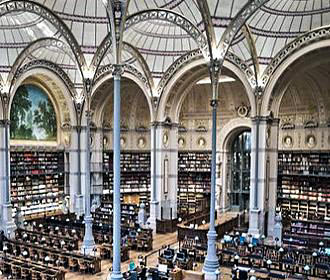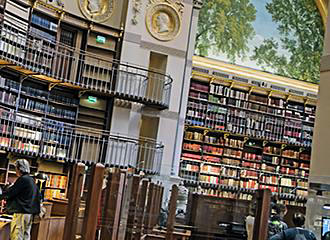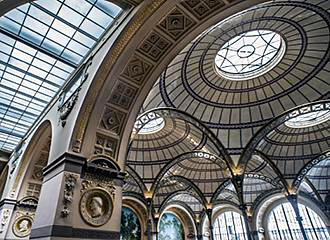Paris Bibliotheque Richelieu-Louvois History
Now part of the BNF, which is the Bibliotheque National de France, this library in Paris holds historical documents and has a rich history dating from the 17th century, along with holding a museum.
The beginnings of the Paris Bibliotheque Richelieu history
The impressive palace was the former residence of Cardinal Mazarin who founded the College des Quatre Nations, which is now known as the Institut de France that is located on the bank of the River Seine opposite The Louvre Museum.
When you look back at the history of the Bibliotheque Nationale de France, or BNF for short, this was originally the royal library. And when it was realised that manuscripts could not be housed within the Palais du Louvre due to lack of space, they were moved in the 1660s on orders of King Louis XIV, to this former private mansion house.
It was opened up to the public in the latter part of the 1600s, and by the end of the 17th century the collections had expanded so much that they ended up utilising the Palais Mazarin along with the Hotel Tubeuf, the Mansart Gallery and other buildings.
And formed in a quadrilateral design, the main royal library was housed here from the first part of the 18th century.
The Paris Bibliotheque Richelieu-Louvois history in the 1800s through to before WWII
The next major stage in the development of the Bibliotheque Richelieu-Louvois library was from 1854 through to 1875, when the architect Henri Labrouste, who had already designed the Bibliotheque Saint-Genevieve, was entrusted with creating specific areas for the library.
One of the main projects was the reading room, which is now known as the Labrouste reading room, but he also designed the storage area for books, which was purely dedicated to printed volumes.
Then from 1875 work continued to enhance and improve the Richelieu library that continued right up until 1932 with the architects Jean-Louis Pascal and Alfred Recoura working on projects including the famous Oval room.
Further adjustments were also made including filling in courtyards, etc, just purely because of the amount the collections were growing, and overseen by Michel Roux-Spitz, these continued up to and after World War II.
The Paris Bibliotheque Richelieu-Louvois history after WWII to the present
It was eventually in 1958 that a reading room containing the Manuscripts Department was created, and then several other areas were organised and transformed allowing for more storage, yet by the 1970s the collections of the Bibliotheque Richelieu-Louvois were so immense that the library was becoming far too small to accommodate the collection.
By the 1980s the Bibliotheque Nationale de France, known as BNF for short, was founded and a new project was announced by the French President, Francois Mitterrand in order to construct a new library that would be one of the most modern, up to date and largest in the world.
So this meant, that once the new library called the Bibliotheque Francois-Mitterrand was completed, the collections at the Paris Bibliotheque Richelieu-Louvois library were reorganised and split up into different areas within the two libraries, and this phase of reorganisation was completed in 1997, with the quadrilateral being completely reorganised.
However, started in 2010, further alterations have been taking place on the quadrilateral area of the Paris Bibliotheque Richelieu-Louvois Library and also many renovations including renovating the Labrouste reading room.
There are also ongoing renovations and improvements being made right up until at least 2020 so that the collections and the museum are more easily accessible to the public and researchers, which means that part of this historical building and library are not currently open.


